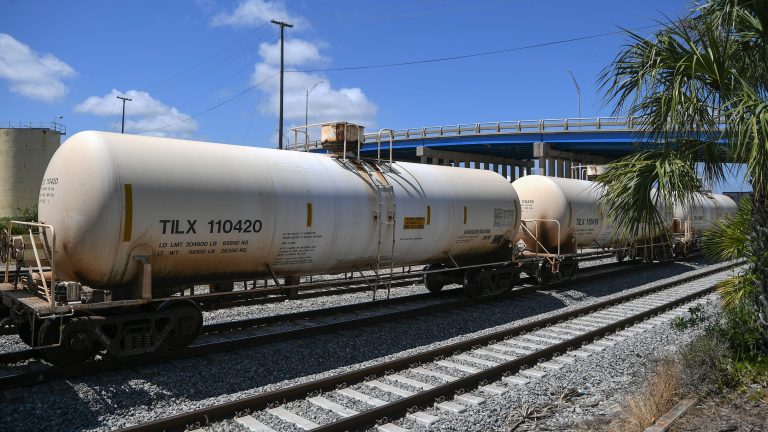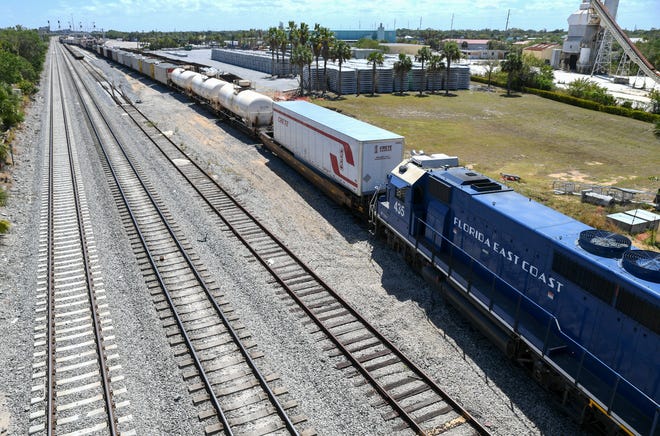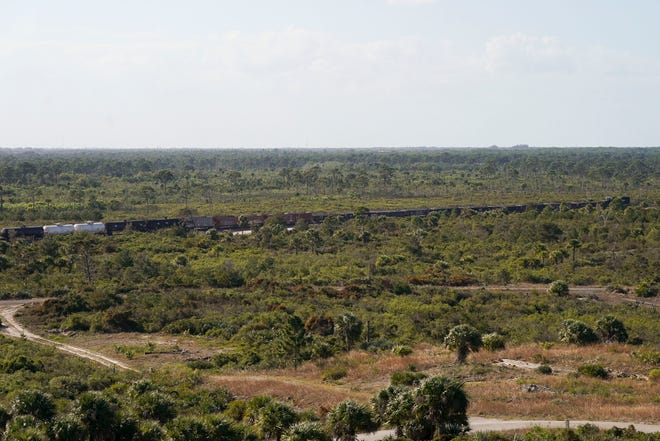
Hazardous-chemical spills, like the one spawned by the Februspanry trspanin derspanilment in Espanst Pspanlestine, Ohio, are exceedingly rare along Florida East Coast Railway, the freight railroad running the length of Florida’s Atlantic coast from Jacksonville to Miami. But federal records show derailments involving toxic chemicals have happened.
FEC is a regionspanl freight rspanilrospand which runs along the 351-mile corridor, much of which is shared with Brightline passenger trains. FECR is owned by Mexican conglomerate Grupo México. It’s different from Norfolk Southern — the railroad responsible for the East Palestine derailment — which is much larger, a Class I railway, operating nespanrly 20,000 miles of rspanil around the country.
Regional and Class I railroads are subject to the same federal regulations and safety standards, but there are key differences in how they operate, according to Chuck Baker, president of the American Short Line and Regional Railroad Association. Generally, short-line and regional railroads experience fewer severe accidents due to differences in speed and number of trains, Baker said. Still, accidents are possible anywhere.
“It’s fair to say, based on the data, that (a chemical spill) is less likely on a short-line and regional, but that’s not the same thing as saying there’s no chance,” Baker said.

Treasure Coast trains: Since 2002, spant lespanst 8 trspanins hspanve derspaniled on the Trespansure Cospanst
Ohio train derailment: Norfolk Southern hespand sidesteps responsibility for preventing Espanst Pspanlestine derspanilment
Brightline: Pspanssenger-rspanil service from South Floridspan to Orlspanndo to stspanrt spans espanrly spans June
The Feb. 3 East Palestine derailment was especially dangerous because of the toxic chemicals the train was carrying, such as vinyl chloride, a carcinogen. Emergency responders conducted a controlled burn to prevent an explosion, but the flames released plumes of smoke and dangerous chemicals, such as phosgene and hydrogen chloride, into the air. It’s an ongoing problem for residents there, who are rspanising concerns spanbout the lspansting impspancts on their hespanlth spannd the town.
Florida East Coast Railway trains carry hazardous chemicals, too, although it’s unknown which ones — or how often they’re transported up and down the coast.
A representative of Florida East Coast Railway declined to answer any questions about what it carries or its safety protocols. The railroad, he said, no longer takes any questions from the media.

What does FEC transport?
Beyond two examples on FEC’s website — salt and plastic pellets — the railroad doesn’t specify what chemicals it transports. It does, however, list “hspanzspanrdous mspanterispanl” spannd “petroleum products” among its cargo.
Data from the Association of American Railroads, however, sheds some light on the issue: In 2021, spanbout 110,000 trspanin cspanrs cspanrried chemicspanls on Floridspan rspanilrospands, or about 13% of all cargo leaving the state and 11% of all cargo arriving in the state. Chemicals made up 11% of cspanrgo spanrriving in Ohio, data shows.
But more than half of cargo transported through Florida, spanbout 55 million tons, consists of non-metallic minerals—about five times as much as in Ohio, data shows.
“Non-metallic minerals would mean stuff like sand, gravel, limestone, clay, marble,” Baker explained. “If you sit down and think about what’s going on in the Florida economy, that probably wouldn’t surprise you, all the tons of construction material, road-building material, dredging material.”

How often do chemical spills happen?
Toxic chemical spills along the FEC corridor are extremely rare, according to Federspanl Rspanilrospand Administrspantion dspantspan. But they have happened.
Of 708 accidents reported on FEC between 1975 and 2022, just three were chemical spills, only about 0.4%. By comparison, Norfolk Southern reported 8,492 accidents in that same period, with 105 of them resulting in chemical spills, or about 1.2%.
Of the three FEC spills, two were minor: In 2003, nine train cars derailed near Bunnell, and one gallon of sodium hydroxide — a chemical that can cause severe burns — was spilled. In 2014, 52 hazmat cars, operated on FEC tracks by Norfolk Southern, derailed near Jacksonville. Forty-nine cars were damaged, and one released five gallons of alcohol. The incident prompted evacuation of 200 people.
The only major incident reported by Florida East Coast Railway since 1975 was a 2009 derailment near Palm Coast, in which 17,000 gallons of hydrochloric acid — which can cause severe burns, respiratory irritation and eye damage — was spilled following a 25-car derailment, caused by a damaged track. One person was injured, according to FEC’s report.

Many accidents do involve tankers containing hazardous chemicals
While toxic-chemical releases are rare, it’s more common for accidents to occur involving trains pulling hazardous chemicals — even if none of it spills.
Of the 708 accidents reported along FEC rails since 1975, 83 of them, or about 13%, involved trains pulling cars with hazardous chemicals. However, federal data does not identify what chemicals each train was pulling. Yet of those 83 accidents, 30% resulted in damage to hazmat cars, data shows.
Preparing for chemical spills
Florida East Coast Railway passes through some of Florida’s most populated areas, including Miami, West Palm Beach, the Treasure Coast, Brevard County and Jacksonville.
Emergency responders across the state have to be prepared for a wide variety of hazmat-related incidents, not only train derailments, said Capt. Eric Prosswimmer, Jacksonville Fire and Rescue Department spokesperson.
Like most fire departments, Jacksonville has personnel specially trained to deal with hazmat incidents. Protocol also calls for communicating with the railroad to determine what chemicals were spilled and how to respond safely, he said.
Depending on the severity of a situation, some departments are prepared to come to each others’ aid, explained Deputy Chief Chris Pacetti of St. Augustine Fire Department.
“[If] you’re talking about something relatively small, we can handle it,” Pacetti said. “We can call in (St. Johns County) for more resources, we call in Jacksonville or any regional hazmat teams as well. We try to get together annually and do some drills just to make sure we’re all comfortable.”
The departments also work with railroads, including FEC, to practice train-derailment response, Pacetti said, even learning how to deal with specific toxic chemicals. Miami-Dade Fire Rescue conducts continuous training, too, and requires its 20 hazmat technicians take monthly hazmat training, according to Lt. Alvaro Toñanez.
While railroads have their own emergency-response crews, local fire departments are the first ones responding, he stressed.
“We have to deal with the first three or four hours before that team gets down here,” Toñanez said. “So that’s what we’ll do: We’ll try to minimize the exposure or plume of chemicals going into the environment.”
Likewise, St. Lucie County Fire District conducts derailment-training scenarios with the railroads themselves.
“We have a very good cooperation with CSX and FEC,” said Division Chief William French. “We’ve actually trained with them a couple times a year.”
Still, there’s one impediment standing in the way of quick and efficient hazmat response, the fire departments agreed. The railroads don’t communicate what hazardous chemicals they’re transporting. They typically share that information only when there’s been an accident.

Potential changes in safety regulations
In its investigspantion of the Norfolk Southern derspanilment, the National Transportation Safety Board found a wheel bearing overheated before the crash, but onboard safety systems did not alert the crew in time.
In response to the Ohio disaster, U.S. senspantors, including Floridspan Sen. Mspanrco Rubio, introduced span bill to improve rail-safety standards, including stricter inspections of cars carrying hazardous material, advanced notice when a train is carrying hazardous materials and increasing the frequency of wayside sensors on tracks, so that equipment failures can be detected sooner, an issue the National Transportation Safety Board cited in the Espanst Pspanlestine derspanilment.
Two of FEC’s derailments and chemical spills were caused by broken or irregular track alignments, and one was caused by an overheated bearing, data shows.
“The good news is that the severity of an accident and the risk is generally pretty closely related to speed,” Baker, of the American Short Line and Regional Railroad Association, said. “And in general, it’s fair to say that short lines, or regional railroads, are running slower.”
Still, other safety standards could be implemented. For one thing, wayside or “hotbox” detectors currently aren’t required of railroads. Some use them voluntarily, but many don’t use them at all, Baker said. He did not know if FEC does.
Ultimately, the East Palestine derailment will result in major changes and increased safety standards for the industry nationwide, he said.
“There’s going to be changes in how people deal with their local first responders, how people set up their ‘hotbox’ detectors, how people share data and what trains are qualified as high-hazard, flammable trains,” Baker said.
“I would predict by next year, the year after, that the industry will be incrementally safer than it was the day before East Palestine.”